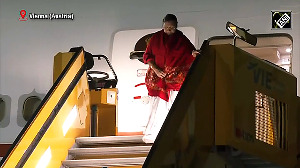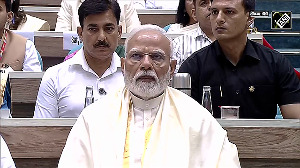Air travellers to Delhi airport, which handles over 35 per cent of the country's air traffic, may expect the usual harrowing times this winter with a thicker fog expected.
On Thursday, the airport witnessed five hours of fog, the first time in the last decade that fog conditions started in November. "Last year was the best, we had only four days of fog in the two months of December and January. One cannot predict what kind of fog we will have this year but the situation will not be as good as last year," said R K Jenamani, director-in-charge, meteorological department, Delhi airport.
An analysis of the last 24 years shows that the fog lasts from December 10 to January 31 for an average time period of 80 hours, he added. The worst case of fog at the airport was in January 2003 which saw 147 hours of fog.
"The fog may affect 60 per cent of the flights," said Andrew Harrison, chief operating officer, Delhi International Airport Ltd, the GMR-led consortium developing and operating the Delhi airport.
On the positive side, the airport now has two runways that can operate under CAT III conditions (visibility below 350 metres) against only one runway last year. The new runway will be used for arrivals and the older one for departures. The secondary runway will remain unused.
Also, the airport has seven RVRs (instruments for measuring visibility ) this year instead of three last year, which will provide a better idea of the visbility.
However, the third runway has been facing problems with its instrument landing systems (ILS). It had closed within a week of starting operations earlier this year when the ILS collapsed. Also, according to sources, the surface movement control radar system, which monitors an aircraft after it lands or before it takes off, does not cover all three runways.
The fact that the net increase in passenger traffic this winter will be a mere 8 per cent over last winter might actually be a blessing since it will mean fewer choke points at the airport.
Meanwhile, capacity on the terminal side has been increased to accommodate around 1,000 more people (including travellers and visitors), and apart from customer care executives who were positioned last year to help visitors, the airport will have valets to take care of the luggage and trolleys.
On the airline side, though carriers like SpiceJet continue to lag in terms of CAT III trained pilots, Jet Airways has geared up to add to its CAT III trained crew.
"We have 330 Indian commanders 45 per cent of whom are CAT III trained this year compared to last year, when we had just three," said a senior Jet Airways pilot.
"We do not have CAT III trained pilots because we do not have CAT III-equipped aircraft to begin with. None of our Boeing 737s are CAT III-equipped. If there are CAT III conditions at the airport, there might be delays in our landings," said JS Dillon, EVP, flight operations, SpiceJet.
Last year, only two out of every ten domestic CAT III landings were made by private carriers and the rest by Air India, which continues to have the best trained crew in terms of CAT III flying.







 © 2025
© 2025